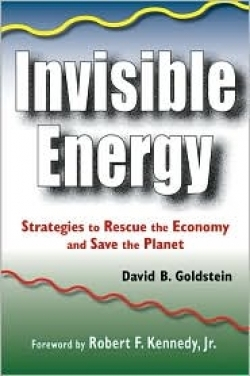Invisible Energy
Strategies to Rescue the Economy and Save the Planet
Energy, invisible and intangible, is the key to survival. David Goldstein takes this idea to a new level in his book, Invisible Energy. The Energy Program co-director for the Natural Resources Defense Council and a MacArthur “genius award” Fellow, Goldstein brings his background in policy research and development to bear in this analysis of the underestimated role of energy efficiency in the United States and beyond.
He asserts, using extremely modest calculations, that “by using known, identified technologies, we can save about thirty percent of energy use over the next twenty years, compared to a business-as-usual scenario.” According to the author, this is possible only through the cooperation of the three big players in the energy universe: consumers, industry, and policy-makers. This can be accomplished through a variety of tools in order to reduce both the cost of energy for consumers and also the overall amount of energy used. Market-based policy approaches are required, such as investing in research and development, implementing managed incentive programs for industry leaders, and disclosing the energy use of products and buildings. Additionally, reforming utility regulations and capping greenhouse emissions are among the list of policy options that Goldstein addresses.
If the author is correct, the benefits of accomplishing this are substantial. Reducing the cost of energy will strengthen the economy by lowering costs and growing the economy while holding inflation down. Using less energy will lead to increased freedom from problematic foreign-based petroleum sources, particularly when overall higher efficiency is coupled with the development of renewable, local energy sources.
Policy makers, industry professionals, and students of energy and environmental policy will want to read this book for its macro-level view of the relationship between the environment, energy, and economic health. Such readers will also appreciate the plethora of references for further research. Goldstein makes two key assumptions: the market works with proper policy and incentive tools, and technological and efficiency innovation can (and will) continue indefinitely. One has to wonder if aggregate energy demand will eventually outrun the ability to cut down on use through efficiency.
Regardless, energy efficiency is often neglected as a key solution for climate change and economic problems. In the end, the unseen energy that we don’t use could make all the difference in the world.
Reviewed by
Gabriela Worrel
Disclosure: This article is not an endorsement, but a review. The publisher of this book provided free copies of the book to have their book reviewed by a professional reviewer. No fee was paid by the publisher for this review. Foreword Reviews only recommends books that we love. Foreword Magazine, Inc. is disclosing this in accordance with the Federal Trade Commission’s 16 CFR, Part 255.

